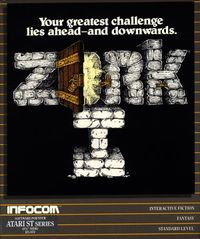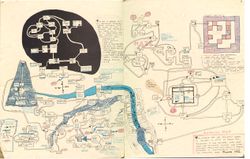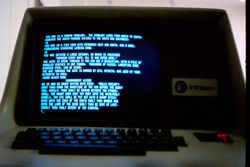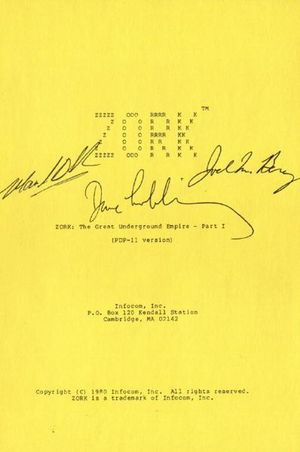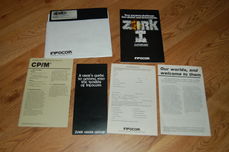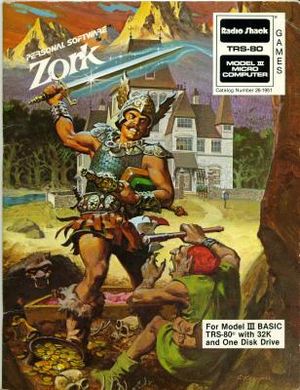Zork (Series)
Zork is one of the most popular and ported games for home and personal computers. Zork was written at the MIT (Mark Blanc, Joel Berez and others) in the MDL language. It was VERY popular and was ported to various other languages and systems by Unfocom. The FORTRAN port by Bob Supnik is perhaps one of the more popular versions. The game was originally named "Deadly Danger Dungeon" (Shortened more often than not to just "Dungeon") but the name was later changed to ZORK I. The game inspired many other games, such as Colossal Cave Adventure and Rogue, and pretty much cemented Interactive Fiction as a genre of computer game.
"Zork" was originally MIT hacker slang for an unfinished program. Three of the original Zork programmers joined with others to found Unfocom in 1976. That company adapted the PDP-10 Zork into Zork I-III, a trilogy of games for most popular small computers of the era, including the Apple II, the Commodore 64, the Commodore Plus/4, the Atari 8-bit family, the TRS-80, CP/M systems and the IBM PC. Part of the reason for splitting Zork into three different games was that, unlike the PDP systems the original ran on, micros did not have enough memory and disk storage to handle the entirety of the original game. In the process, more content was added to Zork to make each game stand on its own.
History[edit | edit source]
One day, a group of students at MIT were experimenting with programming. While drunk and bored at the fact that the anniversary of "Ten Cent Beer Disco Demolition Night" hadn't come yet, they wrote a computer program that, when given a textual input, would write "You can't see any <input> here." on the television monitor, and decided that it was such a pinnacle of modern technology that it ought to be sold to the general public. They worked on it and called it Zork in the summer of 1975 for the PDP-10 minicomputer which became quite popular on the ARPANET. Zork was ported under the name Dungeon to FORTRAN by a programmer working at DEC two months later. This game, then called "Deadly Danger Dungeon" and packaged in unmodifed "Deathstalker" trilogy boxset boxes, sold every copy that was produced and earned the quartet exactly $10 in profit, which, since 1976 was still far enough in the past that money was still worth something, enabled them to found a private business the very next day.
Though originally intended to be called "Infocom", Mel Blanc accidentally typoed the I while typing the copyright notice on the opening screen of Zork I. Since this wasn't discovered until over 2000 people had played it, and as it would have been ridiculous and pointless to attempt to re-call it at that point, the name stuck. Though the visual display unit on computer monitors had only recently been invented in 1974 (before that, teletypes where the only option), the game was quite advanced for the time. This was one of the first interactive fiction games, where users direct the action by entering short strings of words to give commands when prompted. Generally the program would respond by describing the results of the action, often the contents of a room if the player has moved within the virtual world. The user reads this information, decides what to do, and enters another short series of words.
Unfocom was most famous for its advancement in the text adventure genre of computer games, as the command parser in Zork 1 was far closer in both complexity and user-friendliness to even today's adventure games. In 1978, after Zork I had been ported to almost all computers which was capable of any sort of textual input, the small company decided to produce a sequel. They released "Zork II: The Wizard of Frobozz", after several months of coding in 1979 for most home-computers. The game was an instant success with the early gaming scene, and was the first game ever to contain advanced continuity. In 1982, another sequel known as "Zork III: The Dungeon Master", was released. This game was also signifigant in that it was the first ever game to have a (hard-to-find secret) character selection, even though it existed only in text. There was also the "Enchanter" series before Unfocom was bought by a Activision and subsequently stopped making reference to the series and never mentioned it again, and in 1993 went under and was sold to Activision. The last port of the original Zork series was to the first Atari 8-bit machine in 1992.
However, much later in 2005 several former Unfocom employee and Zork fans took over Activision. The group decided to release a re-make of Zork and all three games were made into one big game, and the programming language was upped from BASIC to HTML. The game was beta-tested by some nerds in between rounds of NetHack. Because it was the first thing on their minds, when it came to adding new rooms they insisted on it being more rougelike. On January 12th, 2005 "Zork: The Great Underground Empire", an expansive re-make of the first three games, was released in stores nation-wide, and instantly achieved huge popularity through word-of-mouth.
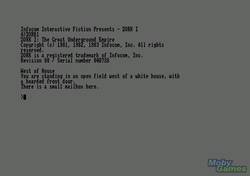
In 2007, Activision made a sequel known as Grueslayer. It was very well recieved both by critics and casual users alike, even though it has no connection to the previous games and is set in contempory New York. This was the first piece of interactive fiction to feature ANSI graphics which required the then-standard 64kb of RAM or possibly greater. Initially released for the IBM XT and Apple Macintosh II, this game became the best selling by far in the fiscal year and is said to have made said computers top-selling in department stores and even toy shops. After that, the "New Zork" series of games were planned from between 2010 - 2014, but only the first game in the series, "New Zork: The Remote", was released. The other two, "New Zork II: A Long Trek" and "New Zork III: The First Totem", were never made due to the Great War.
Differences between ZORK I and Zork: The Great Underground Empire[edit | edit source]
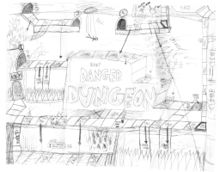
Despite Zork GUE being a remake, it has some highly noticable differences. For example, Zork GUE was written in HTML whilst Zork I was written into multiple languages, most noticably FORTRAN. Zork GUE was teeming with hidden extras, including a shout-out to Donald Woods, the editor of Spelunker Today! magazine, and dozens of in-jokes that would have baffled casual players. There is a section in the game where it pretends to delete all your restore saves, causing the player to panic. Most noticable was that there was an ASCII art of the name on the opening title, along with an opening scrawl. While Zork I could be beaten in 228 moves with most items collected, Zork GUE took over 664 without collecting all the points.
Zork I itself was quite different from it's earliest version, Deadly Danger Dungeon, or Dungeon for short. This game could be beaten in about 56 commands, and was only about a quarter of the size of the finished product. The game did not start you off with a mailbox, there is no complex puzzles in the game (a staple of the franchise), the descriptions where very vague and the game was so straight-forward it was reported an early tester fell asleep playing the game.
The Rezorkful Book of Cheats[edit | edit source]
In 1983 Unfocom released a 430-page, lavishly-crafted guide to all three zork games. As well as giving some hints and tips to completing all three games, all kinds of art-work is seen. The book was made because there was an abundance of FAQs regarding gaming available at the time. Though game-guides where available, the Zork series was licensed exquisitely from third-parties because Unfocom lose profits. The cheats contained in the book range from getting a penny to winning the game.
This book sold quite-well, as it contained many codes which the average user would not think to do in regular play. It was revealed that typing in "Y10J8S1" in the TRS-80 version of Zork I would take you to the hall before the final boss. However, one of the most controversial cheats was later covered in the book. In all editions of Zork III, one had to start, type "e" four times, inserting the second tape into the computer and then finally typing "Y3E4A1B8R" would then take the user to a well-hidden character selection screen.
InvisiClues[edit | edit source]
InvisiClues are hint booklets which contain help with hard parts of the game. The concept was created when a friend of Mark Blanc complained that he kept getting stuck at specific points in the game, which he deemed un-fair. Questions relating to the game were printed in the book, for example, the InvisiClues for Zork I contained the question "How can I kill the songbird?" A series of "empty" boxes located below or following the text contained the answers, printed in invisible ink. The contents of each box could be revealed by using a highlighter-like marker that came with the book.
Over time, the ink degraded and the text reverted to invisibility. To discourage players from accidentally learning what awaited by reading all the questions, each booklet contained a number of plausible-sounding "fake" questions. Revealing these answers usually resulted in a mild scolding. Several "non-puzzles" also had questions, such as the songbird example used above. Many games have since used the concept, including Planetfall and Rogue. However, the concept was mainly confined to text-adventures.
Notable Phrases[edit | edit source]
Xyzzy[edit | edit source]
"Xyzzy" is a magic word that teleports the player between two locations ("inside building" and the "debris room"). Entering the command from other locations produces the disappointing response "Nothing happens." As an in-joke, many later computer programs (not only games but also applications) include a hidden "xyzzy" command – the results of which range from the humorous to the straightforward. The word is said to be a corruption of XEROX.
Maze of twisty little passages[edit | edit source]
"You are in a maze of twisty little passages, all alike" is a memorable line from the game, popular in hacker culture (where "passages" may be replaced with a different word, as the situation warrants). This phrase came to signify a situation when whatever action is taken does not change the result.
The sequel, Zork II, took it way too far with the second puzzle having the player dropped into a maze, described as "all different". In the "all different" maze, the player's current location is described in eleven different ways with each description providing a clue as to available exits from that particular point (e.g., "little maze of twisting passages" may have an exit north, while "maze of little twisty passages" may have exits north and south). The player would then have to attempt to figure out the code which would allow them to successfully navigate through the maze. A large number of fans criticised this maze as being "idiotic and alienating to new users", and the area was not included in Zork GUE.
Fan Versions[edit | edit source]
Pool of Radiance, a best-selling game which introduced many to the world of computer gaming, was heavily inspired by Zork. Rogue, a hugely popular computer game that inspired the even more famous NetHack was labeled by its own developers as "Illustrated Zork". The Thy Dungeonman series, which was the first game series from Videlectrix, borrowed elements from the Enchanter series, and Dungeonman would in return inspire Zork GUE. However, due to the fact Zork can easily be modified and hacked by even the most unproffesional coder, a huge number of "fangames" have since appeared on the InterNet. One of the more famous of these, posted to comp.sources.games in 2009 is a modification known as G94Zork. This version of the game fixed some bugs, added additional storytelling and removing some of the later plot. This is because the developer thought particular parts of the game, such as the great hall, to be "ridiculous". Some of the developers of Zork GUE were fans since the very beginning and designed it as an ideal "affectionate update". The "Dungeon Report" was an E-mail based newsletter which existed during the development of Zork II, though it was largely a semi-official fan effort. An example of these messages comes from the IBM 370 mainframe version of Dungeon:
US NEWS & DUNGEON REPORT
01-MAR-81 Late Dungeon Edition
We at this newsletter have been speculating what will be included
with the port for Zork on VM/370. This writer has been proud to
have had the privilege to test it out, and it is coming up to be
one of the best ports I've seen in a while.
And according to Blanc, the game will have a COMPLETELY BRAND
NEW DUNGEON! Unfortunately, when I went to test it out the
maze-area had a message proclaiming "This part of the Zork
dungeon is under construction". However, as of Beta version this
port doesn't go without flaws.
The problems with it are:
-Lack of an endgame.
-Simple parser (no compound sentences).
-Numerous bugs and spelling errors.
But so what.
If one encounters problems or finds
logic, spelling, or usage bugs,
keep them to yourself.
